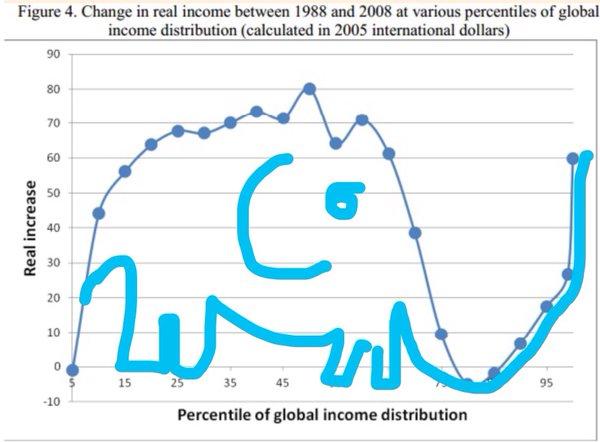Despite many qualities, the Archbishop of Canterbury speaks as though he is shamefully illinformed and lazy-minded about the global economy, making hasty, ill thought out assertions about how society is so horribly unjust, and that the poor are getting the roughest deal of an economy that needs to be distributed less unevenly.
Here is the actual reality of what’s been happening, illustrated in Branco Milanovic’s elephant shape graph of the years 1988 to 2008. The horizontal axis shows global income percentile in terms of the world’s poorest and richest people, and the vertical axis shows the real-terms percentage change in incomes.
The summary of why it’s an elephant shape can be explained in roughly this way.
The world’s very poorest (the very small proportion of people to the far left on the horizontal axis) have not gained significantly. They are the minority that have not yet been able to benefit from globalisation, mostly due to being excluded from entering the global market (for reasons like dictatorships, civil war and lacking basic human rights, but for another significant reason I’ll mention in a moment).
The entirety of the elephant’s body, ending at the top of its head, shows the gains in prosperity of all the rest of the world’s poorest people in emerging countries – it’s the biggest explosion of progression for the most number of people the world has ever seen.
The dip just after that, at the formation of the elephant’s trunk, is the people in the world’s most well off two dozen countries whose incomes haven’t risen to the same extent – but that’s primarily because: a) they are already in the top 75-90% of the world’s wealthiest people who have ever lived, and have consumption and prosperity levels that even their grandparents would marvel at; and b) because much poorer people have been gaining by entering the market and being more competitive (which, if you’re paying attention, is actually of benefit not just to the people in number 2, but also the people in number 3 as they benefit in terms of more affordable consumption of those goods and services).
The people that make up the rest of the elephant’s trunk comprise the world’s richest people. And as expected, they have made significant gains too, because the world’s top entrepreneurs are the main people creating the jobs and opportunities for all the people in groups 2 and 3 – so of course they are going to see gains. They become better off by making large proportions of the global population better off too. And don’t mistakenly think that the world’s richest people are only the yacht-owning multi-millionaires – you only need to earn just over £24,000 per year to be in the world’s top 1% of earners.
Milanovic’s graph isn’t perfect: some of the stats that comprise the low point at the elephant’s trunk are also countries in significant transition periods that hit a low; and faster population growth in the economies of groups 1 and 2 means that the people at the low point at the elephant’s trunk are not always precisely the same people in both 1988 and 2008.
But the general trend holds: although some workers in the 75th percentile have seen their wages fail to rise because of low-wage competition in growing economies, the vast majority of the world’s population are being made better off by globalised trade, not just in terms of rising incomes, but lest we forget, in terms of consumption too (better technology, more goods and services, more affordable products, enhanced communication, fewer working hours, etc).
Finally, I said earlier that there is a minority of people in the world that have not yet been able to benefit from globalisation by being excluded from the global market due to malevolent influences in their own countries. But we cannot ignore the part that politicians in the most prosperous countries play in the continuation of their plight. The sad reality is, there are still too many barriers to free trade, as many of the people in group 1 are kept in group 1 by regulations constructed by governments of people in groups 3 and 4 to favour groups 3 and 4 over groups 1 and 2.
For all those reasons, and more, I think now would be a nice point in human history to let reality and a sense of perspective rule over half-witted, half-thought-out attacks on the free market.
https://www.adamsmith.org/blog/the-elephant-chart-isnt-all-its-cracked-up-to-be [

